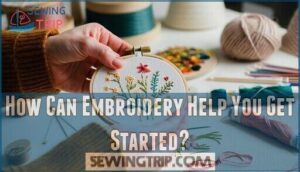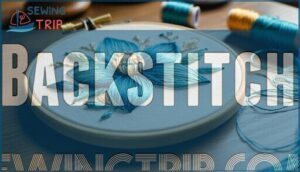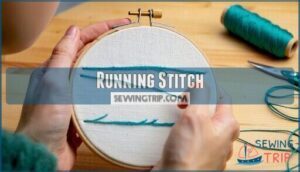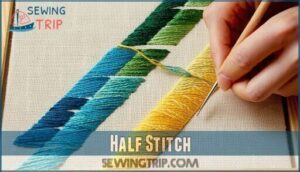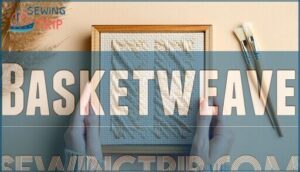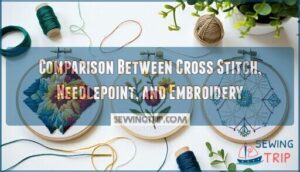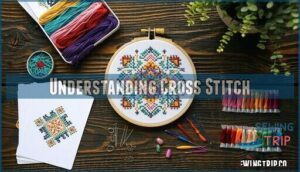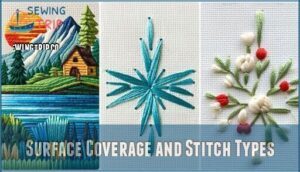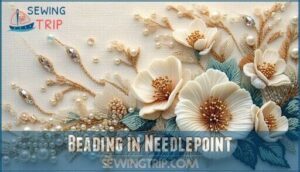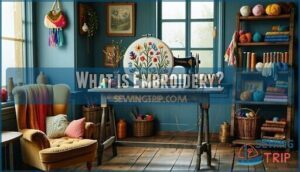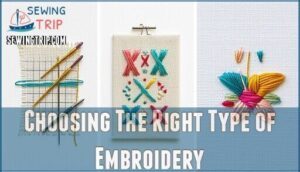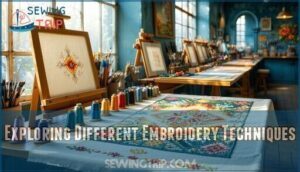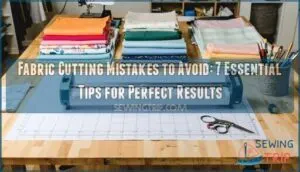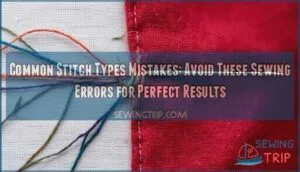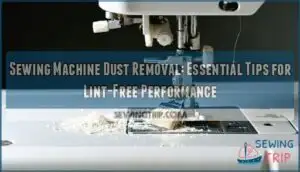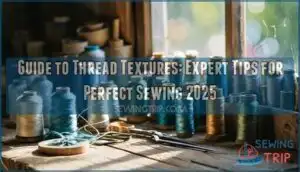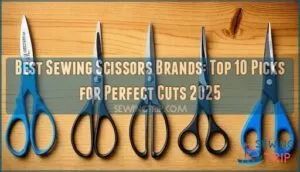This site is supported by our readers. We may earn a commission, at no cost to you, if you purchase through links.
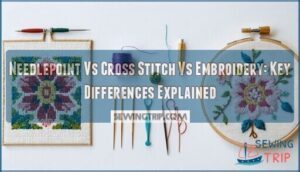 When you’re comparing needlepoint vs cross stitch vs embroidery, think of embroidery as the umbrella term covering all decorative stitching techniques.
When you’re comparing needlepoint vs cross stitch vs embroidery, think of embroidery as the umbrella term covering all decorative stitching techniques.
Cross stitch uses only X-shaped stitches on counted fabric like aida cloth, creating pixelated designs that look like digital art come to life.
Needlepoint employs multiple stitch types on canvas mesh, producing textured, durable pieces perfect for pillows and upholstery.
Each craft uses different fabrics, threads, and needles to achieve distinct results.
Cross stitch offers precision and pattern-following, needlepoint provides durability and texture, while general embroidery gives you creative freedom with endless stitch combinations.
The choice depends on your project goals and preferred working style, which ultimately determines the best technique for your needs.
Table Of Contents
- Key Takeaways
- What Are The Different Types of Embroidery?
- How Can Embroidery Help You Get Started?
- Types of Stitches Used in Embroidery
- Comparison Between Cross Stitch, Needlepoint, and Embroidery
- Understanding Cross Stitch
- Exploring Needlepoint
- What is Embroidery?
- Choosing The Right Type of Embroidery
- Exploring Different Embroidery Techniques
- Frequently Asked Questions (FAQs)
- Conclusion
Key Takeaways
- You’ll find cross stitch easiest as a beginner – it uses only one X-shaped stitch on gridded fabric like Aida cloth, making mistakes forgiving and patterns easy to follow
- Needlepoint creates the most durable pieces – its dense, varied stitches completely cover canvas, making it perfect for functional items like pillows and upholstery that need to withstand regular use
- Embroidery gives you unlimited creative freedom – as the umbrella term for all decorative stitching, it offers countless stitch combinations and techniques for personalized, artistic designs
- Your fabric choice determines your technique – cross stitch requires even-weave fabrics, needlepoint needs sturdy canvas, while general embroidery works on various materials from cotton to silk
What Are The Different Types of Embroidery?
Looking at the broad landscape of needlework, you’ll discover several distinct Embroidery Types that each bring their own character to fabric.
Hand embroidery encompasses traditional techniques like satin stitch, French knots, and chain stitch, offering endless creative possibilities through varied Stitch Variations. Machine embroidery delivers precision and speed, perfect for commercial applications and consistent results.
Traditional hand embroidery offers endless creative freedom, while machine embroidery delivers commercial precision and speed.
Cross stitch creates pixel-like patterns using X-shaped stitches on even-weave fabrics, while needlepoint covers canvas entirely with dense, textured stitches. Surface embroidery decorates fabric tops without full coverage, allowing Fabric Choices to show through.
Each technique transforms fabric into art through its own distinct visual language.
Thread Selection ranges from cotton floss to metallic threads, each affecting your project’s final appearance. Your Needle Techniques depend on your chosen method – blunt tapestry needles for needlepoint, sharp embroidery needles for surface work.
Each technique requires specific tools and approaches, making Stitching Techniques a key consideration when selecting your next project.
How Can Embroidery Help You Get Started?
Starting an embroidery journey transforms creative potential into tangible artistry.
You’ll discover that embroidery serves as both a meditative practice and a practical skill-building foundation for advanced needlework like needlepoint and cross stitch.
Begin your embroidery adventure by focusing on these essential steps:
- Choose quality Starter Kits – Select beginner-friendly packages containing embroidery hoops, needles, embroidery floss, and pre-printed patterns that guide your initial stitching techniques.
- Master Thread Selection fundamentals – Learn to distinguish between cotton, silk, and synthetic threads, understanding how each material affects your finished work’s texture and durability.
- Practice with Beginner Projects – Start with simple designs like basic flowers or geometric patterns that build confidence without overwhelming complexity.
Online Tutorials provide invaluable guidance for mastering Embroidery Basics at your own pace.
These resources demonstrate proper needle threading, fabric preparation, and fundamental stitches that form the foundation for all hand embroidery work.
Each completed project strengthens your skills while building the confidence needed to tackle more challenging needlework techniques.
Types of Stitches Used in Embroidery
Understanding the basic stitches in embroidery will help you choose the right technique for your project.
Each stitch type serves different purposes and creates unique textures that can make or break your finished piece, which is why understanding these basic stitches is crucial.
Backstitch
Backstitch creates the strongest hand stitch in embroidery, forming continuous lines by stitching backward along your path.
You’ll bring the needle up ahead of your last stitch, then insert it at the previous stitch’s endpoint. This technique works perfectly for outlining shapes in cross stitch and needlepoint projects.
Master proper stitch length and tension control for professional results. Choose your thread wisely – single strands work best for fine details.
Practice fabric selection, as backstitch adapts to various materials while maintaining strength and precision. For more information on embroidery techniques, understanding the backstitch basics is essential for achieving quality results.
Running Stitch
Running stitch forms the backbone of embroidery techniques, creating continuous lines through simple up-and-down movements. Your stitch length and thread tension determine the final appearance, while fabric choice affects how smoothly you’ll work.
This foundational stitch technique builds confidence before tackling complex needlepoint or cross stitch projects. Understanding various embroidery stitches is essential for advancing in the craft.
Running stitch essentials:
- Needle selection – Choose based on fabric weight and thread thickness
- Stitch speed – Work at consistent pace for even results
- Pattern creation – Vary spacing for decorative effects
- Foundation work – Perfect base for composite stitches
Master this basic embroidery stitch first.
Half Stitch
Half stitch creates a single diagonal line across fabric intersections, forming half of a complete cross stitch. You’ll find this technique essential for shading and detailed work in both crossstitch and needlepoint projects.
The halfcrossstitch requires careful stitch tension since it provides less canvas coverage than full stitches. Thread choices affect the final appearance, while proper canvas selection guarantees your needlepoint stitches lay flat.
These stitch variations offer incredible flexibility for creating subtle effects in your embroidery work, and they are crucial for achieving the desired final appearance.
Basketweave
Basketweave stitch creates strong, textured surfaces on needlepoint canvas through interlaced diagonal threads.
This weave technique produces dimensional effects that cross stitch can’t match.
- Durability: Interlocking threads resist wear from frequent handling
- Texture: Raised stitches create visual depth and tactile interest
- Coverage: Dense stitch patterns completely fill canvas squares
When selecting fabric for basketweave stitches, choose sturdy needlepoint canvas that supports the thread tension.
This embroidery technique works best with consistent spacing.
Comparison Between Cross Stitch, Needlepoint, and Embroidery
Understanding the differences between these three needlework techniques will help you choose the right approach for your next project.
Each method uses distinct materials, stitches, and tools that create unique results perfect for different applications, which is a complete concept to consider when planning your project, and it involves unique results.
Fabric Used
Your fabric selection determines whether your project succeeds or becomes a tangled mess. Each embroidery technique demands specific materials to achieve professional results.
| Technique | Best Fabric Choices |
|---|---|
| Cross-Stitch | Aida cloth, evenweave fabric, linen |
| Needlepoint | Mono canvas, interlock canvas |
| Hand Embroidery | Cotton, linen, silk blends |
Canvas types matter most for needlepoint—you’ll need that stiff structure to support dense stitching. Cross-stitch thrives on evenweave fabric where you can count threads easily.
Stitch density varies dramatically between techniques, so fabric embroidery requires matching weave patterns to your chosen method, ensuring the best possible outcome for your embroidery technique and resulting in a beautiful piece of work with the right fabric selection.
Threads Used
Thread selection dramatically impacts your project’s appearance and durability. Each embroidery technique demands specific fiber choices to achieve superior results.
| Technique | Primary Thread Types |
|---|---|
| Cross Stitch | Stranded cotton embroidery floss, pearl cotton |
| Needlepoint | Tapestry wool, Persian wool, cotton floss |
| Embroidery | Cotton floss, silk, metallic, specialty threads |
| Texture Focus | Wool for warmth, cotton for precision |
| Color Options | Variegated, solid, metallic, glow-in-the-dark |
Yarn selection depends on your fabric weight and desired texture variations. Cross stitch typically uses divisible stranded cotton, while needlepoint prefers thicker tapestry wool for complete canvas coverage.
General embroidery offers unlimited fiber choices, from delicate silk to bold metallic specialty threads, letting you experiment with different textures and finishes.
Stitches Used
Your stitch selection defines each craft’s character.
Cross stitch relies on X-shaped stitches creating grid-based patterns.
Needlepoint employs multiple stitch types including tent stitch, continental stitch, basketweave, and Gobelin stitch for varied textures.
Embroidery offers unlimited creative freedom with backstitch, satin stitch, and French knots.
| Craft | Primary Stitches |
|---|---|
| Cross Stitch | X-shaped stitches only |
| Needlepoint | Tent, continental, basketweave, Gobelin |
| Embroidery | Backstitch, satin, French knots, chain |
| Complexity | Simple to advanced techniques |
Needle Used
Choosing the right needle transforms your stitching experience from frustrating to fantastic.
Different embroidery techniques require specific needle types to handle varying thread materials and fabric densities effectively.
| Technique | Needle Type | Key Feature |
|---|---|---|
| Needlepoint | Blunt tapestry needle | Large eye, rounded tip |
| Cross Stitch | Sharp tapestry needle | Medium eye, precise point |
| Embroidery | Sharp embroidery needles | Various sizes, sharp tip |
Needlepoint needles feature blunt tips that slide between canvas threads without splitting them. Their large eyes accommodate thick wool threads comfortably.
Cross stitch uses sharp tapestry needles with medium-sized eyes for precise fabric penetration.
Embroidery needles come in multiple sizes with sharp points for detailed work on various fabrics.
Understanding the correct needle size selection is essential for achieving professional-looking results in embroidery and other sewing projects.
Finished Look and Purpose
Each technique creates distinct visual results that serve different purposes.
Cross stitch produces pixel-like patterns perfect for wall art and samplers.
Needlepoint delivers rich textile art with high stitch density, ideal for pillows and upholstery.
Hand embroidery offers delicate, freeform designs that enhance clothing and accessories.
| Technique | Finished Look | Best Applications |
|---|---|---|
| Cross Stitch | Grid-based, geometric patterns | Home decor, personalized gifts |
| Needlepoint | Dense coverage, varied textures | Functional items, structured projects |
| Hand Embroidery | Flowing, artistic designs | Fashion, decorative accents |
Your fabric choice and color schemes substantially impact the final appearance, while design complexity varies between techniques, and understanding these elements is crucial for achieving the desired visual results.
Understanding Cross Stitch
Within the structured world of Cross Stitch Basics, you’ll discover the beauty of X Stitch simplicity.
These Grid Designs transform fabric into Pixel Art through systematic counting and placement.
Cross stitch patterns guide your needle across even-weave fabric, creating crisp geometric designs.
Counted crossstitch requires patience as you follow charts stitch by stitch.
Cross stitch embroidery offers beginners a perfect starting point, while cross stitch kits provide everything needed for success.
Exploring Needlepoint
When you’re ready to tackle needlepoint, you’ll discover a rich embroidery technique that completely covers canvas with dense, varied stitches.
This structured craft offers more complexity than cross-stitch, using multiple stitch types to create durable, textured pieces perfect for home décor and functional items.
Surface Coverage and Stitch Types
Needlepoint achieves complete surface coverage through dense stitch placement, creating rich textures you can’t replicate with other techniques.
Unlike cross stitch patterns that form grid-based designs, needlepoint stitches work together to fill every canvas thread intersection. The tent stitch serves as your foundation—this diagonal workhorse crosses one canvas intersection at a time.
You’ll build stitch density by layering continental and basketweave variations. Different canvas types require adjusted thread choices; mono canvas needs thicker yarn while interlock canvas works with finer threads.
Various stitch types create dimensional effects—some needlepoint stitches produce smooth surfaces while others add sculptural depth. This thorough coverage transforms plain canvas into artwork.
Beading in Needlepoint
Adding beads to your needlepoint creates stunning texture enhancement and dimensionality that transforms ordinary stitches into eye-catching art.
Glass seed beads work best—size 11 for 13-14 mesh canvas, size 14 for finer 18 mesh.
You’ll need beading needles and strong thread like Nymo for secure attachment.
Attach each bead using tent or continental stitches, following the basketweave direction for consistency.
Japanese beads offer superior uniformity, while Czech varieties provide charming irregularity.
Crystal beads add spectacular sparkle but require beading wire due to sharp edges.
Strategic bead integration transforms simple needlepoint into dimensional embroidery.
Use color accents sparingly on focal points like flower centers or animal eyes, or go bold with fully beaded sections.
Unlike cross stitch, needlepoint’s sturdy canvas perfectly supports beads’ weight, creating lasting texture that catches light beautifully, and resulting in a beautiful piece of eye-catching art.
What is Embroidery?
Embroidery is the umbrella term that encompasses all decorative stitching techniques, including both needlepoint and cross-stitch as specialized forms.
You can create embroidery by hand for personalized projects or use machines for consistent, commercial-quality results on everything from clothing to home décor.
Definition and Purpose
Embroidery represents the artistic decoration of fabric using needle and thread, offering countless creative possibilities through diverse techniques and materials.
This ancient craft serves both functional and decorative purposes, allowing you to express personal style while creating lasting pieces.
Understanding embroidery’s definition helps you appreciate its design versatility and material impact on your project goals.
Whether you choose CrossStitch, Needlepoint, or traditional embroidery stitches, each technique carries unique historical context and stitch functionality that influences your final creation, making embroidery a craft with lasting pieces.
Machine Vs. Hand Embroidery
Both approaches offer distinct advantages for different embroidery projects.
Hand embroidery provides superior stitch precision on delicate fabrics like silk and linen, making it ideal for personalized designs with lower production volume requirements.
The skill requirement is higher, but cost analysis favors small batches.
Machine embroidery excels at design complexity and high production volume on durable materials like canvas and polyester.
While initial equipment costs are significant, it’s cost-effective for bulk orders.
Your choice depends on project scale, fabric type, and desired output quality.
History and Characteristics of Needlepoint
Since ancient civilizations first developed needlepoint techniques, this craft has evolved from simple canvas work to sophisticated artistic expression.
You’ll discover needlepoint’s rich heritage spans centuries of cultural development.
- Ancient Origins – Egyptian artisans created the first needlepoint designs using basic canvas and thread combinations
- Canvas Evolution – Medieval craftspeople developed structured mesh systems for consistent stitch placement
- Aristocratic Favor – European nobility embraced needlepoint as refined artistic expression during Renaissance periods
- Modern Revival – Contemporary needlepoint kits make traditional techniques accessible to today’s crafters
Choosing The Right Type of Embroidery
Selecting the right embroidery technique depends on your skill level, fabric choice, and intended use for the finished piece.
Cross stitch works best for beginners using gridded fabrics like Aida cloth, while needlepoint requires stiffer canvases and offers more texture for home décor items, making it a good choice for those looking for a specific texture.
Considerations for Fabric Type and Skill Level
When choosing between needlepoint, cross stitch, and embroidery, fabric difficulty and your skill level work hand-in-hand to determine success.
Cross stitch offers the gentlest learning curve with its single X-shaped stitch on beginner fabrics like Aida cloth.
The even weave provides clear guidelines, making stitch complexity manageable for newcomers.
Needlepoint demands more patience with its multiple stitch types and sturdy canvas requirements.
You’ll master tent, basketweave, and continental stitches while working on mono or interlock canvas.
This advanced technique requires steady hands and consistent tension.
Embroidery spans the widest skill spectrum.
Start with simple backstitch on cotton, then progress to complex surface techniques.
Project suitability depends on matching your abilities with appropriate fabric choices—lightweight cotton for beginners, heavy canvas for experienced stitchers seeking durability.
Desired Finished Product
Your finished project vision determines which embroidery technique will best bring your creative ideas to life. Different methods excel at specific applications based on their unique characteristics and materials.
Project Durability matters most for functional items. Needlepoint creates sturdy surfaces perfect for chair cushions and handbags since its dense stitches completely cover the canvas. Cross stitch offers moderate durability for wall hangings and bookmarks, while hand embroidery provides flexibility for garments and delicate linens.
Aesthetic Appeal varies substantially between techniques:
- Cross stitch produces crisp, geometric patterns ideal for samplers and pixel-art designs
- Needlepoint delivers rich textures and realistic images perfect for decorative artwork
- Embroidery offers unlimited creative freedom for personalized monograms and artistic flourishes.
Intended Use guides your choice. Machine embroidery handles bulk orders efficiently, while hand techniques suit one-of-a-kind gifts. Complexity Level affects timeline—simple cross stitch finishes quickly, whereas intricate needlepoint requires patience. Consider Gifting Potential too; handmade pieces carry sentimental value that recipients treasure.
Exploring Different Embroidery Techniques
If you’re ready to pull out your hoops and threads, exploring different embroidery techniques gives you a front-row seat to history and modern creativity.
Both hand and machine embroidery have their quirks—think of them as the tortoise and the hare.
Try these:
- Choose varied stitches for texture and personality.
- Let fabric and thread selection influence your outcome.
- Use online galleries for design inspiration and skill development.
- Combine needlepoint and cross stitch for a modern take on classic embroidery.
To further refine your skills, consider learning advanced techniques from online courses.
Experiment boldly—each stitch builds your embroidery story, and it’s essential to explore different embroidery techniques with a focus on modern creativity and understanding the tortoise and the hare approach to embroidery.
Frequently Asked Questions (FAQs)
What are the different types of embroidery?
Like threads weaving your story, embroidery offers diverse paths to creativity.
You’ll discover hand embroidery techniques including backstitch, satin stitch, French knots, chain stitch, and blanket stitch, plus machine embroidery for precise, commercial work.
Which type of embroidery should you use?
You’ll want to take into account your skill level and project goals.
Cross-stitch works best for beginners and decorative items, while needlepoint suits functional pieces like cushions.
Machine embroidery handles bulk orders efficiently.
What is the best type of stitch for beginners?
Cross-stitch dominates as the best beginner stitch because it’s forgiving, uses only one X-shaped technique, and mistakes disappear easily into the grid pattern, making it perfect for building confidence.
What is the difference between cross stitch and needlepoint and embroidery?
Embroidery encompasses all decorative needlework techniques, including cross-stitch and needlepoint as specialized forms.
Cross-stitch uses X-shaped stitches on gridded fabric, while needlepoint employs multiple stitch types on canvas for textured designs.
Is cross stitch or needlepoint more difficult?
Think of needlepoint as traversing a dense forest with multiple paths, while cross stitch is like following a single, well-marked trail.
Cross stitch is definitely easier—you’ll master one X-shaped stitch versus needlepoint’s dozen different techniques, making it a more accessible choice for beginners, with cross stitch being the simpler of the two.
What is the easiest needlework to learn?
Cross-stitch is your best bet for diving into needlework.
You’ll master the basic X-shaped stitch quickly, and mistakes are forgiving.
The grid-based patterns guide you step-by-step, making it perfect for beginners before tackling complex needlepoint techniques.
Which embroidery technique requires the most time?
Like a clock’s hands crawling through hours, needlepoint demands the most time investment.
You’ll spend countless hours filling every canvas thread with dense stitches, creating rich textures that cross-stitch’s simple X-patterns can’t match.
Can beginners start with needlepoint or cross stitch?
You’ll find cross-stitch much easier as a beginner. It uses only one simple X-shaped stitch, while needlepoint requires mastering over half a dozen different stitches for varied textures and complexity.
Whats the average cost of starting each craft?
Cross-stitch starter kits cost $10-25, while needlepoint ranges $20- Embroidery supplies start around $15- You’ll need fabric, threads, needles, and hoops—cross-stitch offers the most budget-friendly entry point for beginners.
How long do completed projects typically last?
A family heirloom outlasts fashion trends—so does a well-made project in this craft.
Care with light, washing, and storage means your handiwork easily endures decades, sometimes generations, without losing its unique charm or integrity.
Conclusion
Like choosing between a paintbrush, pencil, or charcoal for your next masterpiece, selecting between needlepoint vs cross stitch vs embroidery depends on your creative vision and practical needs.
Cross stitch delivers precise, pixel-perfect patterns that satisfy detail-oriented crafters.
Needlepoint creates durable, textured pieces perfect for home décor.
General embroidery offers unlimited creative freedom with countless stitch combinations.
Consider your skill level, preferred fabric, and intended use when making your choice, as each technique brings unique rewards to your stitching journey.
- https://www.bbc.com/culture/article/20240613-the-aristocratic-craft-making-a-surprising-comeback
- https://needlepoint.com/blogs/needlepoint-know-how/differences-between-needlepoint-cross-stitch-and-embroidery
- https://blog.anthonythomas.com/needle-craft-statistics-insights-and-more
- https://www.lex18.com/news/not-your-grandmas-needlepoint-why-an-old-school-hobby-is-growing-in-popularity
- https://en.wikipedia.org/wiki/Cross-stitch

